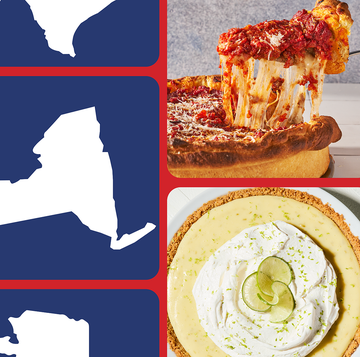Grilling is a staple of summer in America. But as common as it is, most of us wouldn’t claim to be pros. Some of us even feel downright insecure about our abilities. Will the steak stick to the grates? Will the chicken burn before it cooks through? And what if we can’t get those gorgeous grill marks?
As someone who had a "grilling complex" for a long time, I can sympathize. But I’m also here to say that if I can master it, you can too. Follow my golden rules of grilling and you’ll be hosting your next backyard cookout with confidence.
1. Prep Your Grills Grates For Success
Before you even think about putting food on the grill, make sure it’s in good working order. Clean the grates, using a long grill brush to scrape off any charred bits or debris. This will be easiest to accomplish when the grill is already hot, as the heat makes it easier to remove any charred debris. Once the grates are scrubbed clean, make sure to oil them well. A paper towel dipped in oil works great for this. The goal is to lightly grease the grates but not to over-oil them to the point that the oil will drip into the flames and cause flare-ups.
2. Heat That Grill Some More!
Make sure you’re heating the grill for at least 10 minutes before adding the food; 15 is even better! According to Jessica Gavin, certified culinary scientist and food scientist, this substantial preheat time "ensures the grates are sufficiently hot, allowing for desired sear marks on food." It also helps to "create a nonstick surface by closing (the microscopic) pores" on the grill grates. The result is a smoother surface, which leads to less sticking.
What happens if you try to cut short this preheat time? You end up with grayish food that’s been steamed rather than seared—hardly appetizing—that probably also stuck like crazy to those grill grates. Be patient. It’s worth the extra time.
3. Create Direct & Indirect Heat Zones
Some food can be cooked completely over hot and fast heat: burgers, steaks, and some veggies.
But others benefit from a lower, slower cook to ensure they reach the correct internal temperature: chicken, pork, or big cuts of beef. This is why it’s important to create direct and indirect cooking zones.
Don’t freak out: This is easier than you think. Essentially, the goal is to create hotter and cooler areas of the grill. If you’re grilling over a gas grill, this might mean just turning down the heat on one side to create a cooler area. If you’re grilling with charcoal, you’ll want to bank the coals on one side so that the grates directly over the coals stay very hot while the grates that are not directly over the coals are a “cool zone.”
A two-zone set-up isn’t strictly necessary if you only plan to cook beef burgers and hot dogs. But it’s a great tool to keep in your back pocket for when you decide you want to try grilling chicken.
4. Know When To Season Your Food
We all know salting your food adds flavor, but did you know that when you season your food can have a big impact on its texture? Salting meat in advance is typically a win-win: according to Gavin, salting 30 minutes before cooking allows the salt to “penetrate the food,” increasing moisture retention and “resulting in juicier and more flavorful grilled dishes.” On the other hand, salting other, more delicate proteins, like fish, in advance is never a good idea, since the salt will dry out and begin to denature the fish.
If you do season in advance, be aware that the salt will most likely pull moisture out of the meat, making the surface wet. Make sure to blot it dry with a paper towel before grilling: If the protein is wet when it hits the grill, it will steam instead of searing—and no one wants steamed meat at a cook-out.
5. Don’t Fuss With Your Food Too Much
Once the food hits the grill grates, it’s important to leave it alone. Shifting the food too soon or too frequently will prevent it from searing properly and developing grill marks. Also, if you try to move the food before those marks have properly formed, there’s a good chance the food will stick and you’ll end up with ripped proteins and grates with little bits of food stuck to them. Hardly desirable.
If you’re concerned your food might be getting over-charred (otherwise known as burned!), try lifting just the corner with the tongs and taking a peek underneath. If the food is well-marked, you’re probably good to flip. If the marks aren’t dark and the food also seems to be sticking, let it ride.
6. Keep The Lid Closed
Unless you’re actively shifting food around on the grill, keep the lid closed. If you’re cooking with charcoal, keeping the lid closed traps that smoky flavor, allowing it to better sink into the food.
Additionally, keeping the lid closed helps preserve the heat of the grill. According to Gavin, when the lid is closed, it "traps the heat circulating above and below the food, ensuring even cooking." Every time the lid is opened, you lose heat, which "can significantly increase the cooking time." A grill is just like an oven: If you keep opening and shutting the door, it will get cold and your food will suffer.
7. Wait To Glaze Meat Or Vegetables
A sweet and tangy glaze on a piece of grilled chicken or cauliflower is hard to beat, but while you might be tempted to start slathering as soon as that food hits the grill, resist! Glazes and barbecue sauces typically contain a lot of sugar, which can quickly burn when exposed to high heat.
For best results, wait to start glazing until the food is almost finished grilling. I usually start about two minutes before I plan to take it off. This is just long enough for the glaze to meld with the food and caramelize slightly, but not long enough for it to burn.

















